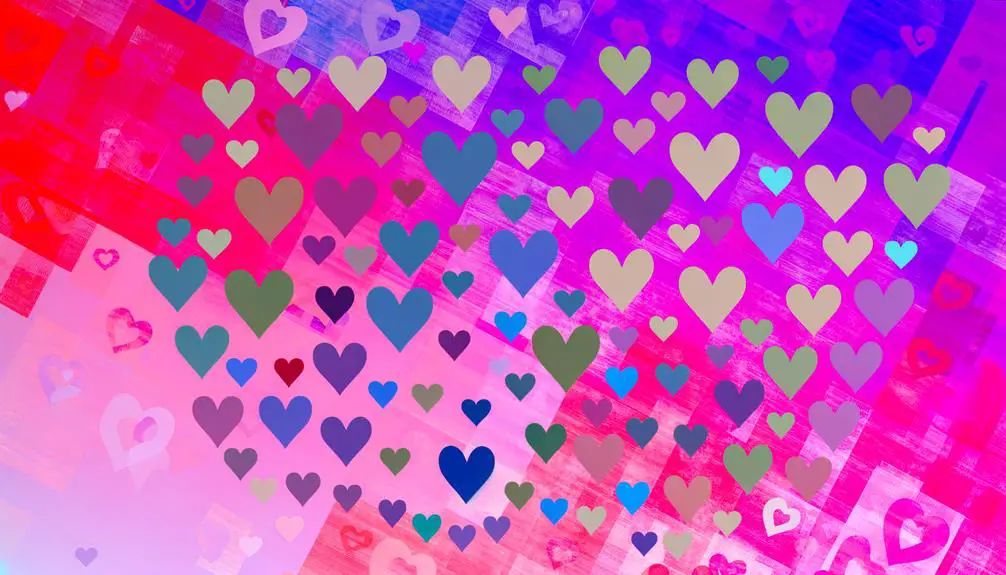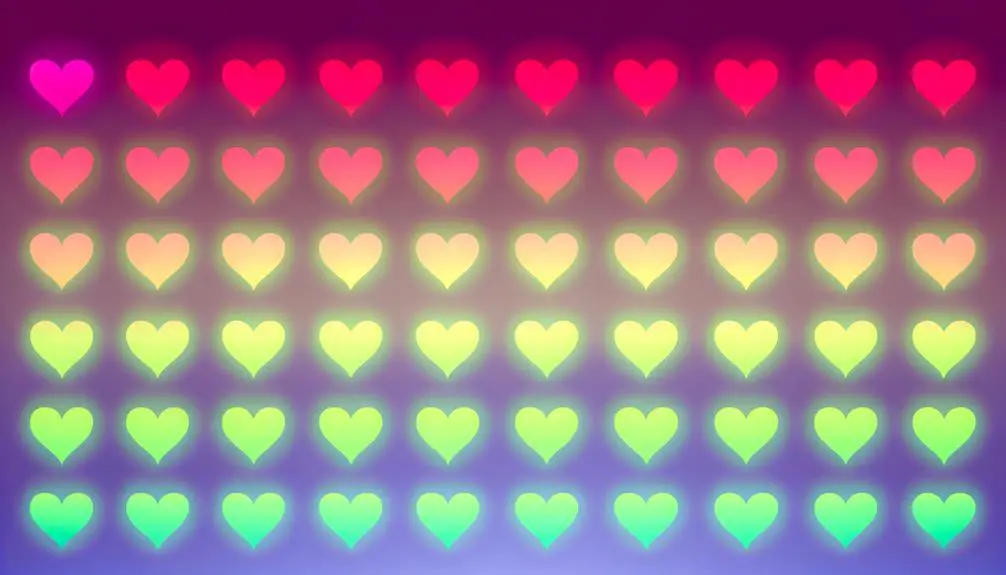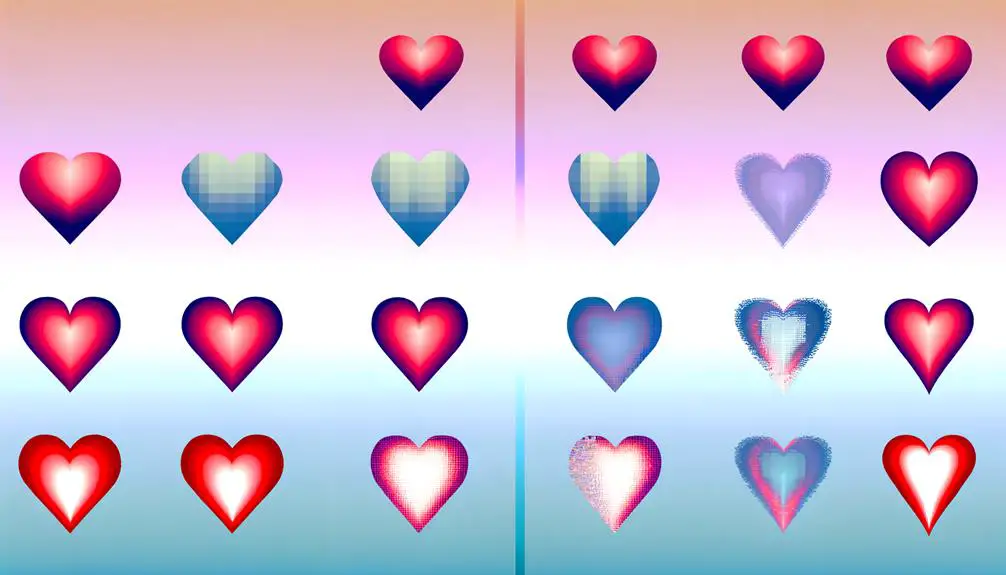What Is the Meaning of the Heart Symbol in Text?
The heart symbol in text serves as a multifaceted emblem of emotional expression and connectivity, rooted in ancient cultures such as Greece, Egypt, and Rome. Historically, it has represented soul, intellect, and love.
Its varied colors convey distinct emotions: red for romantic love, yellow for friendship, green for growth, and black for sorrow. In digital contexts like social media, heart symbols enhance emotional communication, bridging cultural gaps.
Emojis, especially heart emojis, are essential for non-verbal digital interaction, enriching user experiences. The heart symbol's versatility underscores its enduring significance across different cultures and mediums.
Discover more intricate nuances below.

Key Takeaways
- The heart symbol in text often represents love, affection, or deep emotional connection.
- Different heart colors convey varied emotions: red for passion, yellow for friendship, green for growth, purple for wealth, and black for sorrow.
- A broken heart symbol in text denotes heartbreak, sadness, or emotional pain.
- Heart symbols enhance emotional expression in digital communication, bridging cultural and linguistic gaps.
- The heart emoji's popularity reflects its role in fostering emotional connectivity and user interaction online.
Historical Origins

The historical origins of the heart symbol can be traced back to ancient civilizations, where it frequently appeared in art and iconography, symbolizing various forms of emotional and spiritual significance.
In ancient Greece, the heart was seen as the seat of the soul and intellect, whereas in ancient Egypt, it was believed to be the center of life and morality, and often depicted in hieroglyphics.
Similarly, in Roman culture, the heart symbolized love and courage. These varied representations indicate the profound and multifaceted role the heart has played in human culture.
Cultural Significance
The cultural significance of the heart symbol is deeply rooted in its historical symbolism. Different societies have varied interpretations of the heart. Ancient cultures often connected the heart to spiritual and moral dimensions. Contemporary perspectives tend to focus more on romantic and emotional connections. These shifts in interpretation offer insight into the diverse cultural contexts in which the heart symbol operates today.
Historical Symbolism
Tracing the origins of the heart symbol reveals its profound cultural significance across various ancient civilizations.
In ancient Greece, the heart symbol was associated with the concept of the soul and emotional center, particularly linked to the god Eros.
Meanwhile, in ancient Egypt, the heart was considered the seat of intelligence and emotion, pivotal in the afterlife's judgment process.
Similarly, the sacred heart symbol in early Christian iconography represented divine love and compassion.
In these contexts, the heart transcended mere anatomy, embodying a deeper spiritual and emotional essence.
Each culture imbued the heart with meanings reflecting their unique worldviews, illustrating its universal resonance as a symbol of life, love, and human connection throughout history.
Modern Interpretations
In contemporary society, the heart symbol continues to be a powerful emblem, encapsulating a variety of meanings across different cultural contexts and mediums. In Western cultures, it mainly signifies romantic love and affection, often used in digital communication to express emotions concisely.
Conversely, in Eastern traditions, the heart can symbolize moral and emotional integrity, aligning closely with concepts of wisdom and inner strength. Social media platforms have globalized the heart symbol, diversifying its interpretations—ranging from endorsement and support to expressions of empathy and solidarity.
Besides, the heart has infiltrated commercial and branding strategies, evoking customer loyalty and trust. This versatile symbol still maintains its dynamic relevance, adapting to the evolving nuances of contemporary human interaction.
Colors and Meanings

Exploring the diverse color variations of the heart symbol reveals a rich tapestry of meanings across different cultures and contexts. The red heart, universally recognized, typically signifies deep romantic love and passion.
Conversely, the yellow heart often denotes friendship and happiness, particularly in Western cultures. A green heart can symbolize growth, nature, or jealousy, depending on the context.
In some Eastern traditions, a purple heart might represent wealth or nobility. Meanwhile, the black heart often conveys sorrow or a form of dark humor. Each color variation invites nuanced interpretations, reflecting the complex emotional and cultural landscapes in which these symbols are employed.
Understanding these distinctions enhances our grasp of the multifaceted ways in which we express human emotions through text.
Heart Symbols in Social Media
Heart symbols in social media platforms serve as powerful tools for emotional expression, fostering connections across diverse cultures and contexts.
The widespread use and popularity of heart emojis underscore their role in conveying empathy, affection, and solidarity in digital communication.
Emotional Connection Online
Leveraging digital platforms for emotional expression, the heart symbol has emerged as a universal emblem of affection and approval across diverse cultures and social media landscapes. This digital shorthand facilitates emotional connections by transcending linguistic barriers and fostering inclusivity.
The heart symbol's ubiquity in online interactions can be attributed to several key factors:
- Cross-Cultural Understanding: The heart symbol is universally recognized, enabling users from different backgrounds to convey emotions without misinterpretation.
- Emotional Resonance: It effectively communicates feelings of love, support, and empathy, strengthening relational bonds.
- Simplicity and Efficiency: Its uncomplicated design allows for quick and clear emotional expression.
- Platform Integration: Widespread availability across social media platforms enhances its utility and adoption.
Thus, the heart symbol enhances online emotional connectivity by providing a simple yet profound means of expression.
Popularity of Heart Emojis
Building on the emotional connections facilitated by the heart symbol, its popularity as an emoji on social media platforms underscores its profound impact on digital communication dynamics globally.
Across diverse cultures, the heart emoji serves as a universal signifier of affection, support, and empathy. Its usage permeates various contexts, from personal conversations to brand interactions, illustrating its versatility.
Analyzing social media trends, the heart emoji's widespread adoption reveals the human inclination for expressing emotions succinctly yet powerfully. Additionally, the emergence of different heart colors and styles caters to nuanced emotional expressions, enhancing digital user experience.
This cross-cultural appeal demonstrates the heart emoji's role in bridging emotional gaps, fostering a sense of connection in an increasingly digital world.
Emojis and Their Impact

Emojis, particularly the heart symbol, serve as a powerful tool in digital communication, bridging cultural and contextual gaps by conveying emotions succinctly and universally. Their impact is multifaceted, influencing how individuals perceive and interpret messages across different cultures.
The heart emoji, in particular, has several significant effects:
- Universal Understanding: It transcends language barriers, allowing for a shared emotional expression.
- Contextual Clarity: Adds emotional nuance to text, reducing misunderstandings.
- Cultural Adaptation: Variants of the heart emoji cater to regional and cultural differences, enhancing relatability.
- Enhanced Engagement: Increases user interaction and emotional connection in digital platforms.
Analyzing these impacts from a cross-cultural perspective reveals the heart emoji's pivotal role in modern communication.
Emotional Expressions
Emotional expressions, particularly through the use of heart symbols, offer a nuanced means of conveying sentiments that transcend linguistic and cultural boundaries. The heart symbol encapsulates a spectrum of emotions, from romantic love to platonic affection, and even solidarity or empathy, depending on the context.
In Western cultures, a red heart typically signifies romantic love, whereas in Eastern contexts, it may symbolize general well-being or sincerity. This emotive versatility is amplified in digital communication, where the heart symbol mitigates the absence of vocal tone and body language, thereby bridging emotional gaps.
Analyzing its utilization across different cultures reveals a shared human inclination to seek connection and understanding, underscoring the heart symbol's universal relevance in emotional discourse.
Variations and Alternatives

The heart symbol, while universally recognized, manifests in various forms and alternatives across different cultures and contexts, each carrying its own distinct connotations. This diversity in representation highlights the symbol's adaptability and nuanced meanings.
Here are four notable variations:
- Classic Red Heart: Primarily signifies love and romance, widely used in Western cultures.
- Broken Heart: Represents sorrow and heartbreak, often depicted in digital communication to express emotional pain.
- Colored Hearts: Different colors can convey varied emotions; for instance, a yellow heart symbolizes friendship and joy.
- Heart Hands Gesture: Popularized globally, this gesture signifies love and unity, transcending linguistic barriers.
Each variant underscores the heart symbol's rich semiotic versatility, reflecting cultural and contextual subtleties.
Conclusion
The heart symbol, with its diverse historical and cultural significance, continues to evolve in modern communication.
In social media, the red heart emoji is the most popular, used over 1.5 billion times on Twitter alone in 2021. This statistic underscores the symbol's powerful role in expressing emotions globally.
The heart's various colors and forms enable nuanced emotional expression, reflecting its enduring adaptability and relevance across different contexts and cultures.






